Analysis of Deforestation and Water Quality in the Talgua River Watershed (Honduras): Ecosystem Approach Based on the DPSIR Model
Abstract
1. Introduction
2. Materials and Methods
2.1. Characteristics of the Talgua River Watershed
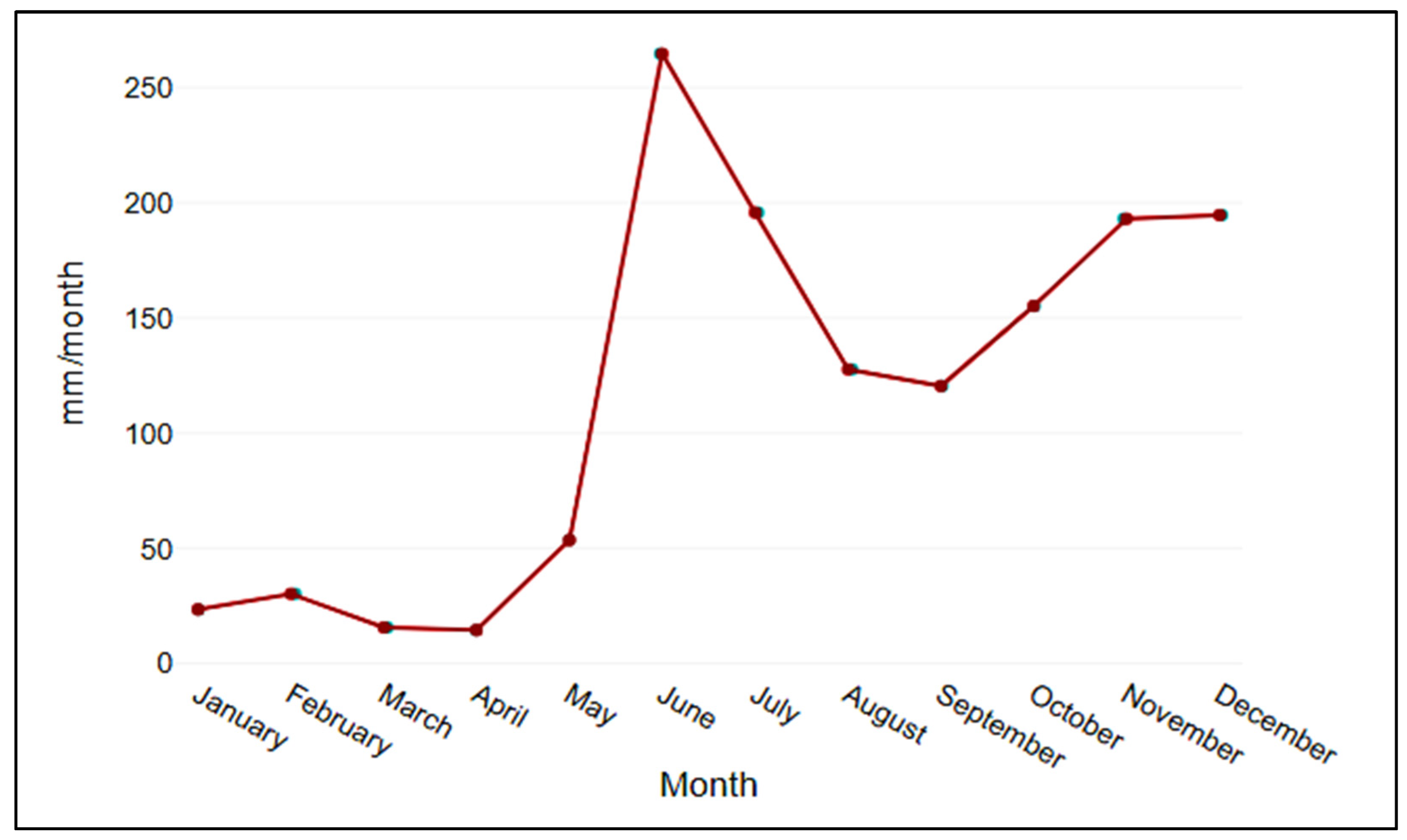
2.2. Valley and Plains Zone Associated with the Watershed
2.3. Water Sampling Collection and Preparation
2.4. Determination of the NSF–QWI and Contamination Indexes
2.5. Satellite Imagery Geoprocessing
2.6. Ecosystem Services (ESs)
2.7. Structure of the DPSIR Model
3. Results and Discussion
3.1. Ecosystem Services (ESs) Provided by the Talgua River Watershed and Surrounding Areas
3.2. DPSIR Model
3.2.1. Driving Forces on Ecosystem Services in the Talgua River Watershed and Surrounding Areas
3.2.2. Pressures on Ecosystem Services (Water) in the Talgua River Watershed and Surrounding Areas
3.2.3. Status of the Ecosystem Services (Water) in the Talgua River Watershed and Surrounding Areas
3.2.4. Impacts on Ecosystem Services (Water) in the Talgua River Watershed and Surrounding Areas
3.2.5. Responses Oriented to Driving Forces, Pressures, State, and Impacts in the Talgua River Watershed and Surrounding Areas
4. Conclusions
Author Contributions
Funding
Institutional Review Board Statement
Informed Consent Statement
Data Availability Statement
Acknowledgments
Conflicts of Interest
References
- Cai, J.; He, Y.; Xie, R.; Liu, Y. A footprint-based water security assessment: An analysis of Hunan province in China. J. Clean. Prod. 2020, 245, 118485. [Google Scholar] [CrossRef]
- Yin, B.; Guan, D.; Zhou, L.; Zhou, J.; He, X. Sensitivity assessment and simulation of water resource security in karst areas within the context of hydroclimate change. J. Clean. Prod. 2020, 258, 120994. [Google Scholar] [CrossRef]
- United Nations. United Nations World Water Development Report 2022. Groundwater: Making the Invisible Resource Visible; United Nations Educational, Scientific and Cultural Organization (UNESCO): Paris, France, 2022; Available online: https://unesdoc.unesco.org/ark:/48223/pf0000382894 (accessed on 5 April 2024).
- WWAP (UNESCO World Water Assessment Programme). United Nations World Water Development Report. Wastewater: The Untapped Resource; United Nations Educational, Scientific and Cultural Organization (UNESCO): Paris, France, 2017; Available online: https://unesdoc.unesco.org/ark:/48223/pf0000247647 (accessed on 10 April 2024).
- OMS/UNICEF (World Health Organization/United Nations Children’s Fund). Progress on Household Drinking Water, Sanitation and Hygiene 2000–2020: Five Years into the SDGs; OMS/UNICEF: Geneva, Switzerland, 2021; Available online: https://www.who.int/publications/i/item/9789240030848 (accessed on 1 April 2024).
- Zou, H.; Wang, L. The disinfection effect of a novel continuous-flow water sterilizing system coupling dual-frequency ultrasound with sodium hypochlorite in pilot scale. Ultrason. Sonochem. 2017, 36, 246–252. [Google Scholar] [CrossRef]
- Chaudhari, A.N.; Mehta, D.J.; Sharma, N.D. Coupled effect of seawater intrusion on groundwater quality: Study of South-West zone of Surat city. Water Supply 2022, 22, 1716–1734. [Google Scholar] [CrossRef]
- IPBES (Intergovernmental Platform on Biodiversity and Ecosystem Services). The Global Assessment Report on Biodiversity and Ecosystem Services: Summary for Policymakers; Díaz, J.S., Settele, E.S., Brondízio, H.T., Ngo, M., Guèze, J., Agard, A., Arneth, P., Balvanera, K.A., Brauman, S.H.M., Butchart, K.M.A., et al., Eds.; Secretaría de IPBES: Bonn, Germany, 2019; Available online: https://zenodo.org (accessed on 25 March 2024).
- Venieri, D.; Karapa, A.; Panagiotopoulou, M.; Gounaki, I. Application of activated persulfate for the inactivation of fecal bacterial indicators in water. J. Environ. Manag. 2020, 261, 110223. [Google Scholar] [CrossRef] [PubMed]
- Jia, X.; O’Connor, D.; Hou, D.; Jin, Y.; Li, G.; Zheng, C.; Ok, Y.S.; Tsang, D.C.W.; Luo, J. Groundwater depletion and contamination: Spatial distribution of groundwater resources sustainability in China. Sci. Total Environ. 2019, 672, 551–562. [Google Scholar] [CrossRef] [PubMed]
- United Nations. United Nations World Water Development Report 2023: Partnerships and Cooperation for Water; Informe de las Naciones Unidas sobre el Desarrollo de los Recursos Hídricos en el Mundo 2023|ONU-Agua; UNESCO: Paris, France, 2023; Available online: https://reliefweb.int/report/world/united-nations-world-water-development-report-2023-partnerships-and-cooperation-water-enit?gad_source=1&gclid=CjwKCAjwjqWzBhAqEiwAQmtgT4n5aOEmi9aq7F63v9Qn-lkBFe_d6JaLfsucUJjPJDXq7m4rb7djPxoCUNkQAvD_BwE (accessed on 20 March 2024).
- Alcamo, J. Water quality and its interlinkages with the Sustainable Development Goals. Curr. Opin. Environ. Sustain. 2019, 36, 126–140. [Google Scholar] [CrossRef]
- Rosati, F.; Faria, L.G.D. Addressing the SDGs in sustainability reports: The relationship with institutional factors. J. Clean. Prod. 2019, 215, 1312–1326. [Google Scholar] [CrossRef]
- Cook, C.; Bakker, K. Water security: Debating an emerging paradigm. Glob. Environ. Chang. 2012, 22, 94–102. [Google Scholar] [CrossRef]
- Sadoff, C.; Muller, M. La Gestión del Agua, la Seguridad Hídrica y la Adaptación al Cambio Climático: Efectos Anticipados y Respuestas Esenciales; TEC Background Papers; Global Water Partnership Comité Técnico: Stockholm, Sweden, 2010; Volume 14, pp. 1–108. Available online: https://gwp.org (accessed on 15 March 2024).
- Brown, R.; Macclelland, N.; Deininger, R.; Tozer, R. A Water Quality Index—Do We Dare? Water Sew. Work. 1970, 11, 339–343. [Google Scholar]
- Dinius, S.H. Design of a Index of Water Quality. J. Am. Water Resour. Assoc. 1987, 23, 833–843. [Google Scholar] [CrossRef]
- CCME. Canadian Drinking Water Quality Guidelines for the Protection of Aquatic Life; Winnipeg Technical Report, CCME Water Quality Index 1.0; CCME: Huntsville, ON, Canada, 2001; pp. 1–13. [Google Scholar]
- UNEP. Global Drinking Water Quality Index Development and Sensitivity Analysis Report. 2007. Available online: https://www.unep.org/resources/report/global-drinking-water-quality-index-development-and-sensitivity-analysis-report-0 (accessed on 15 March 2024).
- Boyacioglu, H. Development of a water quality index based on a European classification scheme. Water SA 2007, 33, 101–106. [Google Scholar] [CrossRef]
- Queralt, R. Calidad de las aguas de los ríos. Tecnol. Agua 1982, 4, 49–57. [Google Scholar]
- Ramírez, A.; Restrepo, R.; Viña, G. Cuatro índices de contaminación para caracterización de aguas continentales: Formulaciones y aplicación. Cienc. Tecnol. Futuro 1997, 1, 1–19. [Google Scholar]
- Ramírez, A.; Restrepo, R.; Cardeñosa, M. Índices de Contaminación para Caracterización de Aguas Continentales y Vertimientos. Formulaciones. Cienc. Tecnol. Futuro 1999, 1, 89–99. [Google Scholar]
- Brink, B.J.E.T.; Hosper, S.H.; Colijn, F. A Quantitative Method for Description & Assessment of Ecosystems: The AMOEBA-approach. Mar. Pollut. Bull. 1991, 23, 265–270. [Google Scholar] [CrossRef]
- Torres, P.; Cruz, C.H.; Patiño, P.J. Índices de calidad de agua en fuentes superficiales utilizadas en la producción de agua para consumo humano. Una revisión crítica. Rev. Ing. Univ. Medellín 2009, 8, 79–94. Available online: https://scielo.org.co (accessed on 10 March 2024).
- Nayak, J.G.; Patil, L.G.; Patki, V.K. Artificial neural network based water quality index (WQI) for river Godavari (India). Mater. Today Proc. 2023, 81, 212–220. [Google Scholar] [CrossRef]
- Mehta, D.J.; Yadav, S.M. Meteorological drought analysis in Pali District of Rajasthan State using standard precipitation index. Hydrol. Sci. Technol. 2022, 15, 1–10. [Google Scholar] [CrossRef]
- Yan, T.; Shen, S.L.; Zhou, A. Indices and models of surface water quality assessment: Review and perspectives. Environ. Pollut. 2022, 1, 119611. [Google Scholar] [CrossRef]
- Mendoza, M.E.; Granados, E.L.; Geneletti, D.; Pérez-Salicrup, D.R.; Salinas, V. Analysing land cover and land use change processes at watershed level: A multitemporal study in the Lake Cuitzeo Watershed, Mexico (1975–2003). Appl. Geogr. 2011, 31, 237–250. [Google Scholar] [CrossRef]
- Hasan, S.S.; Zhen, L.; Miah, M.G.; Ahamed, T.; Samie, A. Impact of land use change on ecosystem services: A review. Environ. Dev. 2020, 34, 100527. [Google Scholar] [CrossRef]
- Feng, H.; Wang, S.; Zou, B.; Nie, Y.; Ye, S.; Ding, Y.; Zhu, S. Land use and cover change (LUCC) impacts on Earth’s eco-environments: Research progress and prospects. Adv. Space Res. 2023, 71, 1418–1435. [Google Scholar] [CrossRef]
- Boerema, A.; Rebelo, A.J.; Bodi, M.B.; Esler, K.J.; Meire, P. Are Ecosystem Services Adequately Quantified? J. Appl. Ecol. 2017, 54, 358–370. [Google Scholar] [CrossRef]
- Durand, A.; Leglize, P.; Benizri, E. Are Endophytes Essential Partners for Plants and What Are the Prospects for Metal Phytoremediation? Plant Soil 2021, 460, 1–30. [Google Scholar] [CrossRef]
- Yu, R.; Deng, X.; Yan, Z.; Shi, C. Dynamic evaluation of land productivity in China. Popul. Resour. Environ. 2013, 11, 253–260. [Google Scholar] [CrossRef]
- Maxim, L.; Spangenberg, J.H.; O’Connor, M. An analysis of risks for biodiversity under the DPSIR framework. Ecol. Econ. 2009, 69, 12–23. [Google Scholar] [CrossRef]
- Niemeijer, D.; de Groot, R.S. Framing environmental indicators: Moving from causal chains to causal networks. Environ. Dev. Sustain. 2008, 10, 89–106. [Google Scholar] [CrossRef]
- Pinto, R.; de Jonge, V.N.; Neto, J.M.; Domingos, T.; Marques, J.C.; Patrício, J. Towards a DPSIR driven integration of ecological value, water uses and ecosystem services for estuarine systems. Ocean. Coast. Manag. 2013, 72, 64–79. [Google Scholar] [CrossRef]
- Ahmed, S.N.; Anh, L.H.; Schneider, P. A DPSIR Assessment on Ecosystem Services Challenges in the Mekong Delta, Vietnam: Coping with the Impacts of Sand Mining. Sustainability 2020, 12, 9323. [Google Scholar] [CrossRef]
- Santos, E.; Fonseca, F.; Santiago, A.; Rodrigues, D. Sustainability Indicators Model Applied to Waste Management in Brazil Using the DPSIR Framework. Sustainability 2024, 16, 2192. [Google Scholar] [CrossRef]
- Akbari, M.; Memarian, H.; Neamatollahi, E.; Shalamzari, M.J.; Noughani, M.A.; Zakeri, D. Prioritizing policies and strategies for desertification risk management using MCDM-DPSIR approach in northeastern Iran. Environ. Dev. Sustain. 2021, 23, 2503–2523. [Google Scholar] [CrossRef]
- Labianca, C.; de Gisi, S.; Todaro, F.; Notarnicola, M. DPSIR Model Applied to the Remediation of Contaminated Sites. A Case Study: Mar Piccolo of Taranto. Appl. Sci. 2020, 10, 5080. [Google Scholar] [CrossRef]
- Liu, S.; Deichmann, M.; Moro, M.A.; Andersen, L.A.; Li, F.; Dalgaard, T.; McKnight, U.S. Targeting sustainable greenhouse agriculture policies in China and Denmark: A comparative study. Land Use Policy 2022, 119, 106148. [Google Scholar] [CrossRef]
- Gari, S.R.; Guerrero, C.E.O.; Uribe, B.A.; Icely, J.D.; Newton, A. A DPSIR-analysis of water uses and related water quality issues in the Colombian Alto and Medio Dagua Community Council. Water Sci. 2018, 32, 318–337. [Google Scholar] [CrossRef]
- Agramont, A.; van Cauwenbergh, N.; van Griesven, A.; Craps, M. Integrating spatial and social characteristics in the DPSIR framework for the sustainable management of river basins: Case study of the Katari River Basin, Bolivia. Water Int. 2022, 47, 8–29. [Google Scholar] [CrossRef]
- Wantzen, K.M.; Alves, C.B.M.; Badiane, S.D.; Bala, R.; Blettler, M.; Callisto, M.; Cao, Y.; Kolb, M.; Kondolf, G.M.; Leite, M.F.; et al. Urban Stream and Wetland Restoration in the Global South—A DPSIR Analysis. Sustainability 2019, 11, 4975. [Google Scholar] [CrossRef]
- Quevedo, J.M.D.; Uchiyama, Y.; Kohsaka, R. A blue carbon ecosystems qualitative assessment applying the DPSIR framework: Local perspective of global benefits and contributions. Mar. Policy 2021, 128, 104462. [Google Scholar] [CrossRef]
- Obubu, J.P.; Odong, R.; Alamerew, T.; Fetahi, T.; Mengistou, S. Application of DPSIR model to identify the drivers and impacts of land use and land cover changes and climate change on land, water, and livelihoods in the L. Kyoga basin: Implications for sustainable management. Environ. Syst. Res. 2022, 11, 11. [Google Scholar] [CrossRef]
- Kosamu, I.B.M.; Makwinja, R.; Kaonga, C.C.; Mengistou, S.; Kaunda, E.; Alamirew, T.; Njaya, F. Application of DPSIR and Tobit Models in Assessing Freshwater Ecosystems: The Case of Lake Malombe, Malawi. Water 2022, 14, 619. [Google Scholar] [CrossRef]
- Wang, B.; Yu, F.; Teng, Y.; Cao, G.; Zhao, D.; Zhao, M. A SEEC Model Based on the DPSIR Framework Approach for Watershed Ecological Security Risk Assessment: A Case Study in Northwest China. Water 2022, 14, 106. [Google Scholar] [CrossRef]
- Nurbayani, S.; Dede, M. The Effect of COVID-19 on White-Collar Workers: The DPSIR Model and Its Semantic Aspect in Indonesia. Int. J. Soc. Cult. Lang. 2022, 10, 73–88. [Google Scholar] [CrossRef]
- Argeñal, F. Variabilidad Climática y Cambio Climático en Honduras. SERNA-PNUD. 2010. Available online: https://academia.edu (accessed on 5 January 2024).
- Sönke, K.; Eckstein, D.; Dorsch, L.; Fischer, L. Global Climate Risk Index 2016: Who Suffers most from Extreme Weather Events? Weather-Related Loss Events in 2014 and 1995 to 2014. In Think Tank & Research. 2015. Available online: http://www.germanwatch.org/en/cri (accessed on 20 February 2024).
- Sandoval, J.T.R.; Rodríguez, A.S. Análisis morfométrico y biofísico en la cuenca del río Talgua, Honduras. Cienc. Lat. Rev. Cient. Multidiscip. 2021, 5, 12024–12042. [Google Scholar] [CrossRef]
- CIAT (Centro Internacional de Agricultura Tropical). Mapa Geológico de Honduras. 1999. Available online: https://www.semanticscholar.org/paper/Mapa-Geologico-de-Honduras-Ciat/2e799cecc3308d3a4aa1360d0a968552fee909c3 (accessed on 15 March 2024).
- Sandoval, W.M.R. Landscape Heterogeneity and Complexity: Implications for Terrestrial Carbon and Water Cycles; North Carolina State University, Forestry and Environmental Resources: Raleigh, NC, USA, 2017; pp. 1–203. Available online: https://repository.lib.ncsu.edu/server/api/core/bitstreams/72a3645f-ae5a-4dae-af45-53fef0b4ddf4/content (accessed on 5 February 2024).
- WRB (IUSS Working Group). World Reference Base for Soil Resources. In International Soil Classification System for Naming Soils and Creating Legends for Soil Maps, 4th ed.; International Union of Soil Sciences (IUSS): Vienna, Austria, 2022; Available online: https://obrl-soil.github.io (accessed on 6 January 2024).
- FAO (Food and Agriculture Organization of the United Nations). Guía para la Descripción de Suelos, 4th ed.; FAO: Roma, Italy, 2009; ISBN 978-92-5-305521-0. Available online: https://www.fao.org/publications/card/en/c/0f070cdd-1b6d-53fa-add1-5c972fb299d2/ (accessed on 17 March 2024).
- NASA (National Aeronautics and Space Administration). 2024. Available online: https://power.larc.nasa.gov/beta/data-access-viewer/ (accessed on 5 June 2024).
- Sosa, S.I.K.; Samora, F.U.V. Evaluación Ecológico—Hidrológica del Plan de Manejo de la Microcuenca del Río Talgua, Olancho; Escuela Agrícola Panamericana: Zamorano, Honduras, 2006; pp. 1–53. Available online: https://bdigital.zamorano.edu/server/api/core/bitstreams/ceefd917-b74f-4d58-be35-31187f9a82f9/content (accessed on 10 April 2024).
- ICF (Instituto de Conservación Forestal). Mapa Cobertura Forestal. 2018. Available online: http://geoportal.icf.gob.hn/geoportal/main (accessed on 5 January 2024).
- BS EN ISO 5667-14:2016; Water Quality—Sampling—Guidance on Quality Assurance and Quality Control of Environmental Water Sampling and Handling. ISO: Geneva, Switzerland, 2014. [CrossRef]
- Mendoza, L.G.; Rosas, D.; Zamar, S.; Nickisch, M.B.; INTA (Instituto Nacional de Tecnología Agropecuaria). Protocolo de Muestreo, Transporte y Conservación de Muestras de Agua con Fines Múltiples (Consumo Humano, Abrevado Animal y Riego); Ministerio de Agricultura, Ganadería y Pesca: Montevideo, Uruguay, 2011; pp. 1–11. Available online: https://www.produccion-animal.com.ar/agua_bebida/107-Protocolo_Aguas_INTA.pdf (accessed on 5 January 2024).
- Rice, E.W.; Baird, R.B.; Eaton, A.D. Standard Methods for the Examination of Water and Wastewater, 23rd ed.; American Public Health Association: Washington, DC, USA; American Waterworks Association: Denver, CO, USA; Water Environment Federation: Alexandria, VA, USA, 2017; ISBN 9780875532875. [Google Scholar]
- Ramalho, R.S. Tratamiento de Aguas Residuales; Editorial Reverté, S.A.: Barcelona, Spain, 2003; pp. 1–284. [Google Scholar]
- Murrell, J.A.L.; Badía, M.M.R.; Álvarez, B.R.; Hernández, N.M.R.; Pérez, M.H. Bacterias indicadoras de contaminación fecal en la evaluación de la calidad de las aguas: Revisión de la literatura Revista CENIC. Cienc. Biol. 2013, 44, 24–34. Available online: http://www.redalyc.org/articulo.oa?id=181229302004 (accessed on 10 March 2024).
- WHO (World Health Organization). A Global Overview of National Regulations and Standards for Drinking-Water Quality, 2nd ed.; World Health Organization: Geneva, Switzerland, 2021; Available online: https://www.who.int/publications/i/item/9789241513760 (accessed on 5 February 2024).
- Lavie, E.; Bermejillo, A.; Morábito, J.A.; Filippini, M.F.; Salatino, S.E. Contaminación por fosfatos en el oasis bajo riego del río Mendoza. Rev. Fac. Cienc. Agrar. 2010, 42, 169–184. Available online: https://uncu.edu.ar (accessed on 3 March 2024).
- Fernández, N.; Ramos, G.; Solano, F. Una Herramienta para la Valoración de la Calidad del Agua; Vicerrectoria de Investigaciones—Unipamplona—Libros y Software; Universidad de Pamplona: Pamplona, Colombia, 2005. [Google Scholar]
- NASA/USGS (National Aeronautics and Space Administration/U.S. Geological Survey). Landsat 7|Servicio Geológico de EE. UU. 2024. Available online: https://usgs.gov (accessed on 2 March 2024).
- QGIS.org. QGIS 3.34 Geographic Information System. QGIS Association. 2024. Available online: http://www.qgis.org (accessed on 1 February 2024).
- Haines-Young, R.; Potschin-Young, M. Common International Classification of Ecosystem Services (CICES) V5.2 and Guidance on the Application of the Revised Structure. 2023. Available online: https://cices.eu/ (accessed on 8 April 2024).
- Carnohan, S.A.; Trier, X.; Liu, S.; Clausen, L.P.W.; Clifford-Holmes, J.K.; Hansen, S.F.; Benini, L.; McKnight, U.S. Next generation application of DPSIR for sustainable policy implementation. Curr. Res. Environ. Sustain. 2023, 5, 100201. [Google Scholar] [CrossRef]
- Forest Trens. Transformaciones del Paisaje Rural en Honduras: Explorando el Nuevo Mapa Forestal y de Cobertura de la Tierra del País y sus Implicaciones Políticas para REDD+ y AVA-FLEGT. 1–10. 2014. Available online: https://forest-trends.org (accessed on 2 April 2024).
- Tsakiris, G. Proactive Planning Against Droughts. Procedia Eng. 2016, 162, 15–24. [Google Scholar] [CrossRef]
- Hanson, D.L.; Steenhuis, T.S.; Walter, M.F.; Boll, J. Effects of soil degradation and management practices on the surface water dynamics in the Talgua river watershed in Honduras. Land Degrad. Dev. 2004, 15, 367–381. [Google Scholar] [CrossRef]
- Sandoval, J.T.R.; Rodríguez, A.S. Vulnerability to climate variability of productive livelihoods in the Talgua watershed, Honduras. Discov. Sustain. 2022, 3, 18. [Google Scholar] [CrossRef]
- Racines, C.E.N.; Rojas, F.A.M.; Herrera, L.L.L.; Bonilla, D.O.; Sánchez, J.M.C. Desarrollo de los Escenarios Climáticos de Honduras y Módulo Académico de Capacitación. CIAT-PNUD-Dirección Nacional de Cambio Climático de MiAmbiente. 2018; pp. 1–140. Available online: https://aguadehonduras.gob.hn/files/Reporte_Final_Escenarios3cncch_vFinal_lr.pdf (accessed on 2 May 2024).
- Barrenetxea, C.O.; Serrano, A.P.; Delgado, M.N.G.; Vidal, F.J.R.; Blanco, J.M.A. Contaminación Ambiental. Una Visión Desde la Química, 1st ed.; Editora Paraninfo S.A.: Madrid, Spain, 2011; pp. 1–590. [Google Scholar]
- Orozco, C.d.l.M.; López, H.E.F.; Chávez, A.D.; Corral, J.A.R. Cambio climático y el impacto en la concentración de oxígeno disuelto en el Lago de Chapala. Rev. Mex. Cienc. Agríc. 2011, 2, 381–394. Available online: https://scielo.org.mx (accessed on 2 March 2024).
- Alfaro, J.D.B.; Castro, G.C.; Araya, G.S. Determinación de nitritos, nitratos, sulfatos y fosfatos en agua potable como indicadores de contaminación ocasionada por el hombre, en dos cantones de Alajuela (Costa Rica). Tecnol. Marcha 2017, 30, 15–27. [Google Scholar] [CrossRef]
- López, M.E.P.; Sanchez-Martinez, M.G.; de la Rosa, M.G.V.; Leon, M.T. Eutrophication levels through San Pedro-Mezquital River Basin. J. Environ. Prot. 2013, 4, 45–50. [Google Scholar]
- Meza, L.J.G. Estandarización de las Técnicas de Fosfatos y Cloruros en Aguas Crudas y Tratadas para el Laboratorio de la Asociación Municipal de Acueductos Comunitarios (AMAC) en el Municipio de Dosquebradas; Universidad Tecnológica de Pereira: Pereira, Colombia, 2011; pp. 1–57. Available online: https://utp.edu.co (accessed on 2 April 2024).
- Castillo, A.G.P.; Rodríguez, A. Índice fisicoquímico de la calidad de agua para el manejo de lagunas tropicales de inundación. Rev. Biol. Trop. 2008, 56, 1905–1918. [Google Scholar]
- Avalos, G.A.T.; González, E.A.L. Disminución de sólidos de aguas grises mediante un proceso de aireación. Ra Ximhai 2017, 13, 393–404. Available online: https://www.redalyc.org/articulo.oa?id=46154070023 (accessed on 15 February 2024). [CrossRef]
- Chibinda, C.; de los Arada-Pérez, C.M.; Pérez-Pompa, N. Caracterización por métodos físico-químicos y evaluación del impacto cuantitativo de las aguas del Pozo la Calera. Rev. Cuba. Quím. 2017, 29, 303–321. [Google Scholar]
- Hernández, E.A.G.; Flores, G.C. Uso de suelo y calidad del agua. Caso de estudio: Reserva de la Biosfera Los Volcanes. Rev. Latinoam. Ambiente Cienc. 2017, 8, 41–67. Available online: https://buap.mx (accessed on 3 March 2024).
- Goyenola, G. Guía para la utilización de las Valijas Viajeras—Alcalinidad. Determinación de la Alcalinidad Total. Red de Monitoreo Ambiental Participativo de Sistemas Acuáticos. RED MAPSA. Versión 1.0. 2007. Available online: https://www.studocu.com/es-mx/document/universidad-autonoma-metropolitana/laboratorio-de-fisicoquimica-computacional/alcalinidad-alcalinidd/27653794 (accessed on 2 March 2024).
- Escobedo, M.M.; Zaidi, M.; Real-de León, E.; Rivadeneyra, S.O. Prevalencia y factores de riesgo en Yucatán, México para litiasis urinarias. Rev. Salud Pública 2022, 44, 541–545. Available online: https://www.insp.mx/salud/index.html (accessed on 5 March 2024).
- Ortega, L.M.R.; Vidal, L.A.; Vilardy, S.Q.; Díaz, L.S. Análisis de la contaminación microbiológica (coliformes totales y fecales) en la bahía de santa marta, caribe colombiano. Acta Biol. 2008, 13, 87–98. Available online: https://unal.edu.co (accessed on 27 February 2024).
- Chará, J.; Pedraza, G.; Giraldo, L.; Hincapié, D. Efecto de los corredores ribereños sobre el estado de quebradas en la zona ganadera del río La Vieja, Colombia. Agrofor. Am. 2006, 45, 72–78. Available online: https://repositorio.catie.ac.cr/handle/11554/7728 (accessed on 1 March 2024).
- Freeze, A.R.; Cherry, J.A. Groundwater, 1st ed.; Prentice-Hall: Hoboken, NJ, USA, 1979; pp. 1–624. [Google Scholar]
- Doran, J.W.; Parkin, T.B. Quantitave indicators of soil quality: A minimum data set. Methods for assessing soil quality. Soil Sci. Soc. Am. 1996, 49, 25–37. [Google Scholar] [CrossRef]
- Pérez, M.A.L. El impacto del Ordenamiento Territorial y Catastral en el Modelo Valuatorio de Honduras. Milímetro 2020, 6, 35–51. Available online: https://researchgate.net (accessed on 4 January 2024).
- Moreno, H.S.; Bolívar-Anillo, H.J.; Soto-Varela, Z.E.; Aranguren, Y.; Gonzaléz, C.P.; Daza, D.A.V.; Anfuso, G. Microbiological water quality and sources of contamination along the coast of the Department of Atlántico (Caribbean Sea of Colombia). Preliminary results. Mar. Pollut. Bull. 2019, 142, 303–308. [Google Scholar] [CrossRef] [PubMed]
- Yu, D.; Shi, P.; Liu, Y.; Xun, B. Detecting land use and water quality relationships from the view point of ecological restoration in an urban area. Ecol. Eng. 2013, 53, 205–216. [Google Scholar] [CrossRef]
- Mello, K.; Valente, R.A.; Randhir, T.O.; Santos, A.C.A.; Vettorazzi, C.A. Effects of land use and land cover on water quality of low-order streams in Southeastern Brazil: Watershed versus riparian zone. Catena 2018, 167, 130–138. [Google Scholar] [CrossRef]
- Molina, M.C.; Roa-Fuentes, C.A.; Zeni, J.O.; Casatti, L. The effects of land use at different spatial scales on instream features in agricultural streams. Limnologica 2017, 65, 14–21. [Google Scholar] [CrossRef]
- Cruz, M.A.S.; Gonçalves, A.A.; Aragâo, R.; Amorim, J.R.A.; Mota, P.V.M.; Srinivasan, V.S.; Garcia, C.A.B.; Figueiredo, E.E. Spatial and seasonal variability of the water quality characteristics of a river in Northeast Brazil. Environ. Earth Sci. 2019, 78, 68. [Google Scholar] [CrossRef]
- De Figueiredo, H.P.; de Figueiredo, C.R.P.; Barros, J.H.d.S.; Cosntantino, M.; Magalhães-Filho, F.J.C.; de Moraes, P.M.; da Costa, R.B. Water quality in an urban environmental protection area in the Cerrado Biome, Brazil. Environ. Monit. Assess. 2019, 191, 117. [Google Scholar] [CrossRef]
- Cunha, D.G.F.; Sabogal-Paz, L.P.; Dodds, W.K. Land use influence on raw surface water quality and treatment costs for drinking supply in Sao Paulo State (Brazil). Ecol. Eng. 2016, 94, 516–524. [Google Scholar] [CrossRef]
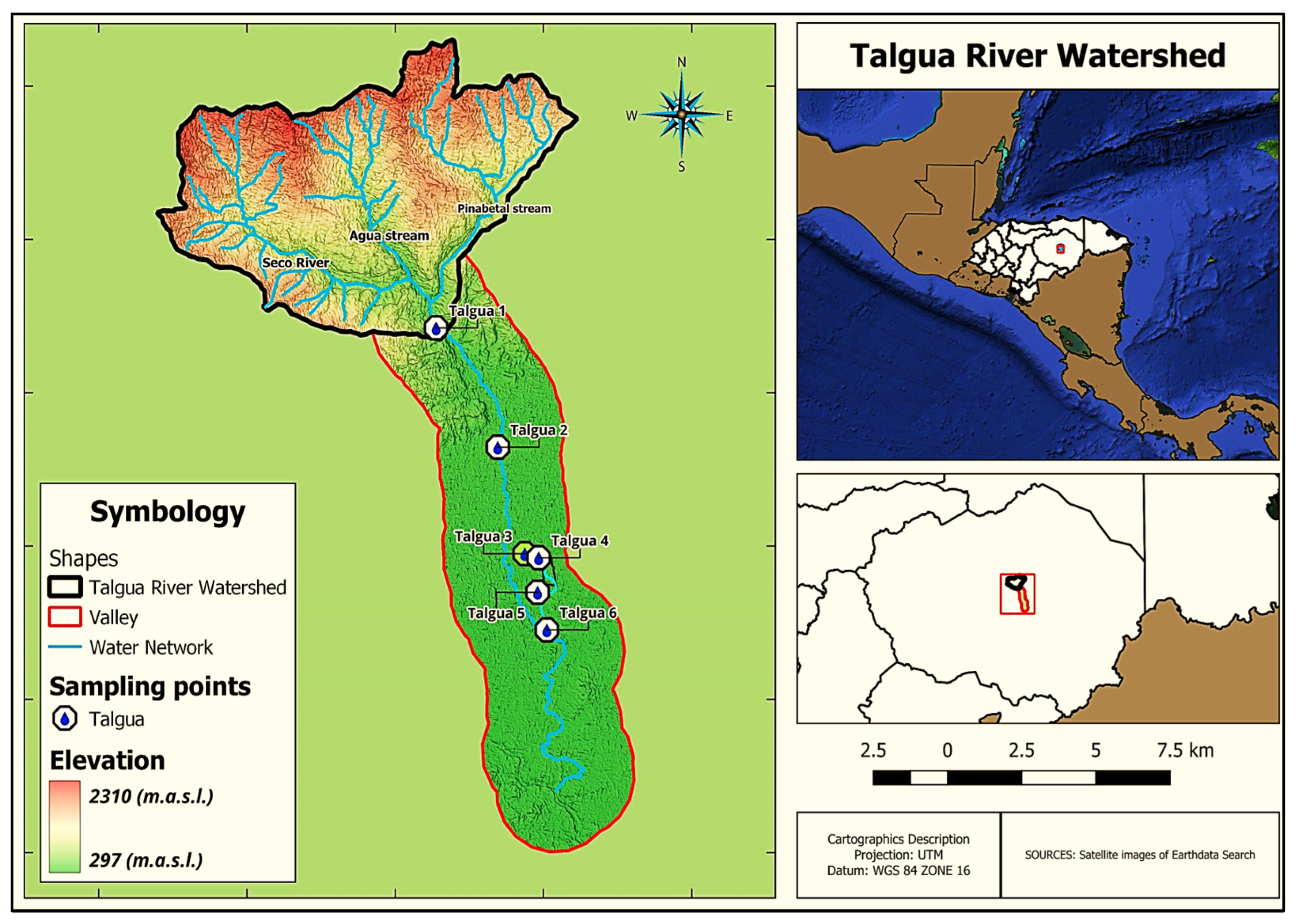
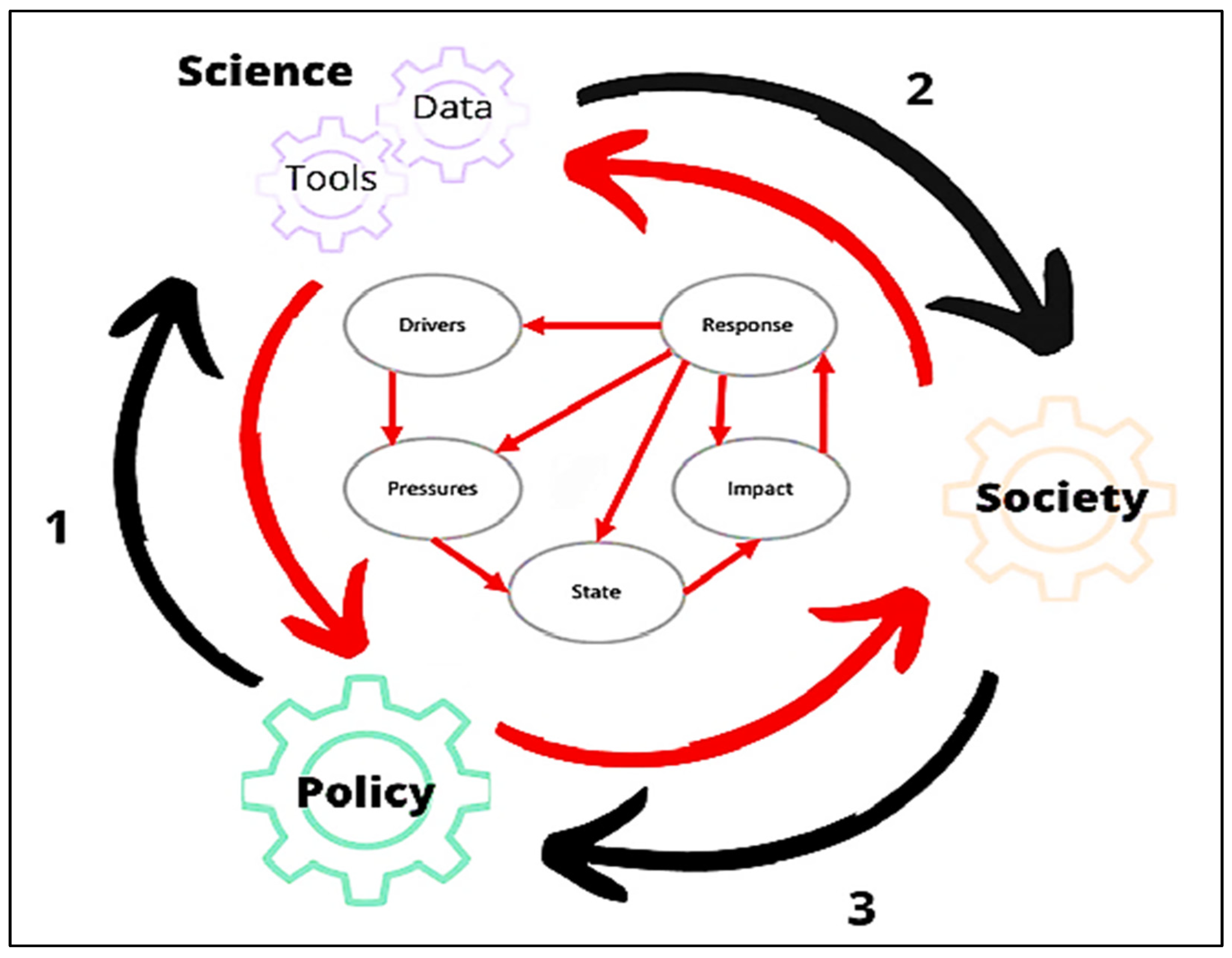

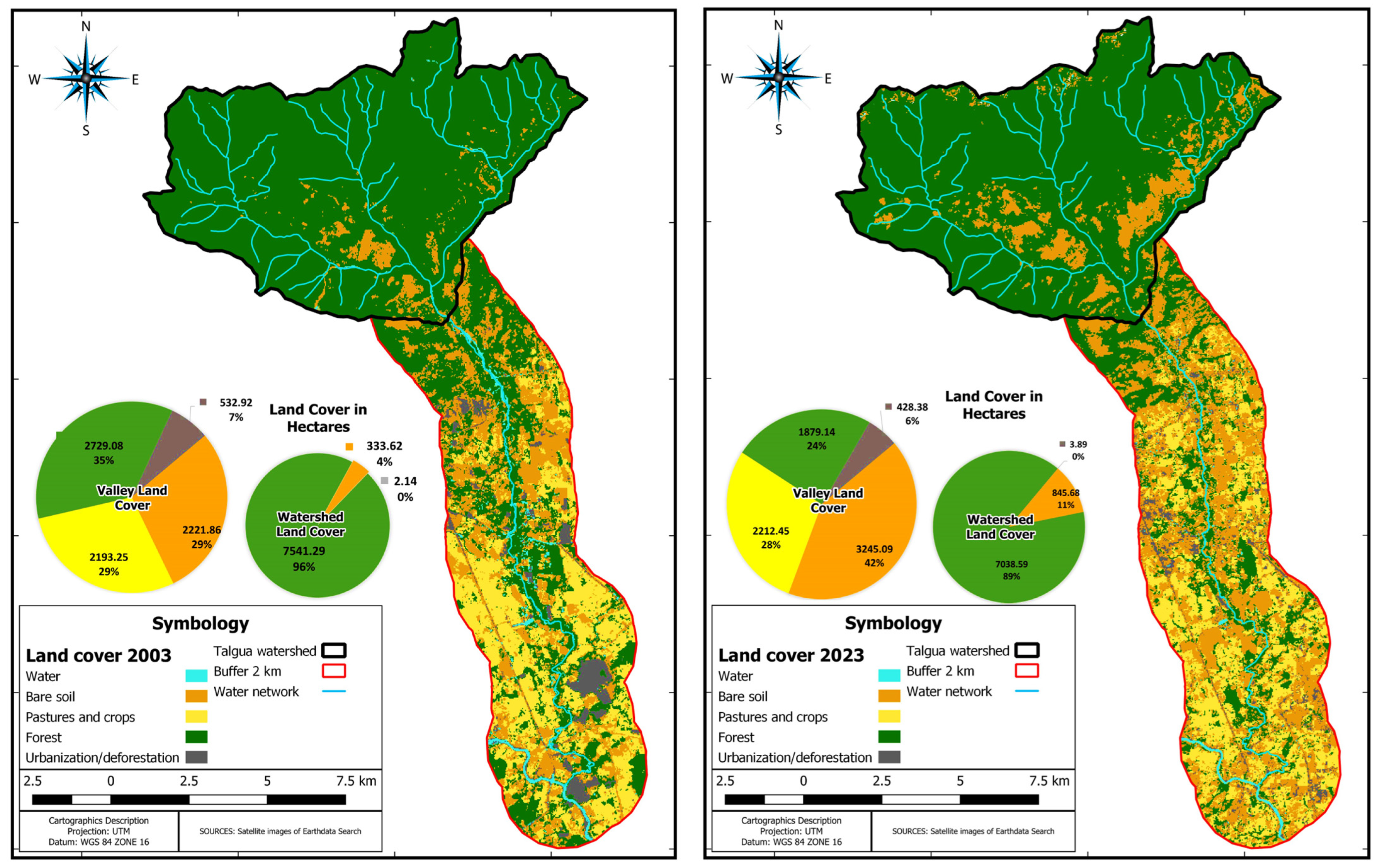
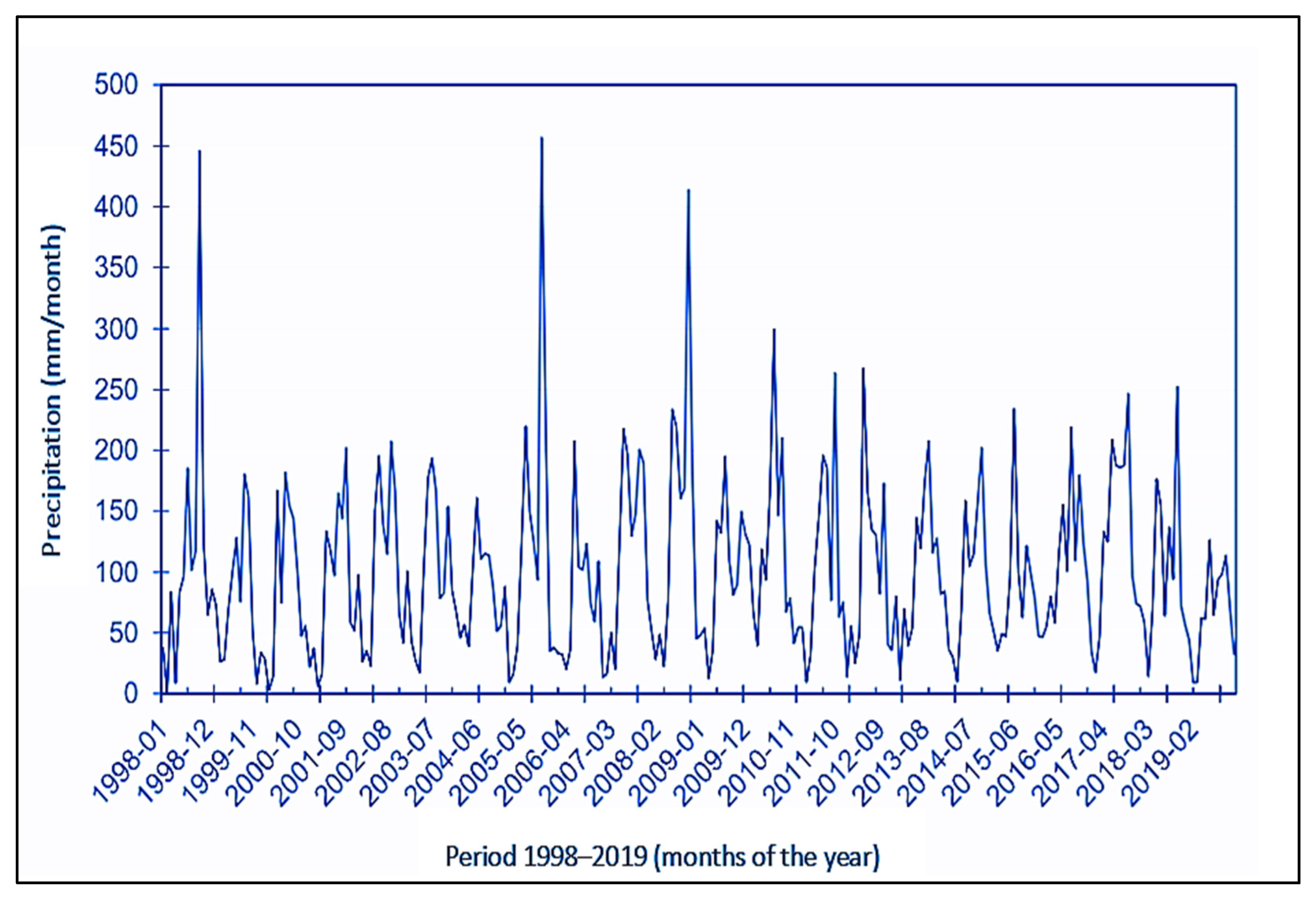
| Index | Parameter (Unit) | Weight a | Minimum and Maximum Acceptable Range | Aggregation Formula | NSF–WQI Classification |
|---|---|---|---|---|---|
| NSF–WQI [16] | BOD5 (mg/L) | 0.11 | 3–8 mg/L [64] | NSF–WQI = (6) | 91–100 = Excellent 71–90 = Good 51–70 = Medium 26–50 = Bad 0–25 = Very bad |
| FCs (NMP/100 mL) | 0.16 | 0–20 NMP/100 mL [65] | |||
| NO3− (mg/L) | 0.10 | 0–40 mg/L [66] c | |||
| PO43− (mg/L) | 0.10 | 0–0.7 mg/L [67] | |||
| T (°C) | 0.10 | 15–34 °C [66] c | |||
| pH | 0.11 | 6.5–8.5 mg/L [66] c | |||
| DO (mg/L) b | 0.17 | 4–8 mg/L [66] c | |||
| TDSs (mg/L) | 0.07 | 200–2500 mg/L [66]c | |||
| Td (NTU) | 0.08 | 0.3–25 NTU [66] c |
| ES | Section | Group/Classification Codes for Classes |
|---|---|---|
| Provisioning | Biotic/ biophysical | Cultivated plants (terrestrial/aquatic) for nutrition, materials, or energy (1.1.1.1, 1.1.1.2, 1.1.2.1). |
| Animals (reared/aquatic) for nutrition, materials, or energy (1.1.3.2, 1.1.4.1). | ||
| Wild plants (terrestrial and aquatic) for nutrition, materials, or energy (1.1.5.1, 1.1.5.2) and (1.1.5.3) * | ||
| Wild animals (terrestrial and aquatic) for nutrition, materials, or energy * (1.1.6.1, 1.1.6.2). | ||
| Genetic material from animals, plants, algae, or fungi * (1.2.1.1, 1.2.1.3, 1.2.2.2). | ||
| Abiotic/ geophysical | Surface water used for nutrition, materials, or energy * (4.1.1.1, 4.1.1.2). | |
| Ground water used for nutrition, materials, or energy * (4.1.2.1, 4.1.2.2). | ||
| Regulation and maintenance | Biotic/ biophysical | Reduction of nutrient load and mediation of wastes or toxic substances and nuisances of anthropogenic origin * (2.1.1.2, 2.1.2.1, 2.1.2.2, 2.1.2.3). |
| Erosion control; hydrological cycle and regulation of water flow and reference flows of extreme events * (2.2.1.1, 2.2.2.1, 2.2.2.2, 2.2.3.1). | ||
| Risk mitigation and life cycle maintenance, habitat, and gene pool protection * (2.2.3.2, 2.2.3.3, 2.2.3.4, 2.3.2.1, 2.3.2.2, 2.3.2.3, 2.3.2.4, 2.3.2.5). | ||
| Pest and disease control * (2.3.3.1, 2.3.3.2). | ||
| Regulation of soil quality and water conditions (2.3.4.1, 2.3.4.2) and (2.3.4.3, 2.3.5.1) *. | ||
| Composition and atmospheric conditions (2.3.6.1, 2.3.6.2). | ||
| Abiotic/ geophysical | Mediation of waste, toxic substances, and other nuisances by non-living and anthropogenic processes (5.1.1.2, 5.1.1.3, 5.1.1.4, 5.1.2.1). | |
| Maintenance of physical, chemical, and abiotic conditions (5.2.2.1) * and (5.2.2.2). | ||
| Cultural | Biotic/ biophysical | Direct, in situ, and external interactions with living systems that depend on presence in the environmental environment (3.1.1.1) and (3.1.1.2, 3.2.1.1, 3.2.1.2, 3.2.1.3, 3.2.1.4) *. |
| Indirect interactions with living systems * (3.3.1.1). | ||
| Elements of living systems that are indirectly appreciated and meaningful to people without their presence in the environmental environment and other biophysical characteristics appreciated in people’s own right (3.4.1.1, 3.4.1.2, 3.4.2.1, 3.4.2.2). | ||
| Abiotic/ geophysical | Direct, indirect, in situ, and external interactions with geophysical systems that depend on presence in the environmental environment and with geophysical systems * (6.1.1.1, 6.1.1.2, 6.2.1.1, 6.2.1.2, 6.2.1.3, 6.2.1.4, 6.3.1.1). | |
| Elements of geophysical systems that are indirectly appreciated and important to people without their presence in the environment * (6.4.1.1, 6.4.1.2). | ||
| Other biophysical elements of species or ecosystems that are cherished in their own right by people (6.4.2.1, 6.4.2.2). |
| Sample | Results of Physicochemical and Microbiological Parameters | |||||||||||
|---|---|---|---|---|---|---|---|---|---|---|---|---|
| pH | BOD5 (mg/L) | DO (mg/L) | NO3− (mg/L) | PO43− (mg/L) | T (°C) | TDSs (mg/L) | Td (NTU) | EC (µS/cm) | Alk (mg/L) | Hd (mg/L) | FCs (NMP/ 100 mL) | |
| Talgua 1 | 8.00 | 3.70 | 6.50 | 0.30 | 0.10 | 22.40 | 110.00 | 2.83 | 213.00 | 123.00 | 117.00 | n.a |
| Talgua 2 | 8.22 | 9.50 | 6.65 | 0.53 | 0.50 | 25.40 | 164.00 | 4.90 | 310.00 | 147.00 | 129.00 | 920.00 |
| Talgua 3 | 8.40 | 18.20 | 4.70 | 0.50 | 0.10 | 23.20 | 192.20 | 1.04 | 366.00 | 190.00 | 200.00 | 2.00 |
| Talgua 4 | 7.44 | 35.40 | 4.10 | 2.70 | 3.20 | 24.80 | 271.40 | 7.50 | 469.00 | 242.20 | 266.80 | 920.00 |
| Talgua 5 | 7.30 | 110.00 | 4.30 | 2.50 | 3.10 | 26.10 | 214.90 | 4.07 | 393.00 | 200.00 | 215.00 | 130.00 |
| Talgua 6 | 8.40 | 15.20 | 6.55 | 1.50 | 1.00 | 24.50 | 178.30 | 6.00 | 326.00 | 150.20 | 160.00 | n.a |
| Sample | Parameters and Values Considered in the Determination of the NSF–WQI | ||||||||||
|---|---|---|---|---|---|---|---|---|---|---|---|
| pH | BOD₅ | OS | NO3− | PO43− | Δ°C | TDSs | Td | FCs | NSF–WQI | Classification | |
| Talgua 1 | 10.92 | 8.16 | 13.54 | 11.60 | 11.52 | 10.20 | 7.42 | 9.05 | - | 82.41 | Good |
| Talgua 2 | 8.38 | 3.96 | 12.69 | 9.65 | 6.00 | 8.50 | 5.40 | 6.90 | 3.65 | 65.13 | Medium |
| Talgua 3 | 7.68 | 1.56 | 4.80 | 9.65 | 9.60 | 8.50 | 5.15 | 7.67 | 14.56 | 69.17 | Medium |
| Talgua 4 | 10.21 | 0.55 | 2.82 | 9.15 | 2.00 | 8.50 | 4.43 | 6.48 | 3.65 | 47.79 | Bad |
| Talgua 5 | 10.18 | 0.55 | 3.28 | 9.25 | 2.06 | 8.50 | 4.94 | 7.03 | 6.66 | 52.45 | Media |
| Talgua 6 | 9.07 | 2.55 | 13.75 | 11.46 | 4.80 | 10.20 | 6.78 | 8.40 | - | 67.01 | Media |
| Samples | Contamination Index | ||||||
|---|---|---|---|---|---|---|---|
| ICOpH | ICOMI | ICOMO | ICOTemp | ICOSUS | ICOTRO | BPI | |
| Talgua 1 | 0.03 | 0.70 | 0.34 | 0.00 | 0.31 | Eutrophic | n.a |
| Talgua 2 | 0.06 | 0.83 | 0.39 | 0.00 | 0.47 | Eutrophic | 8.50 |
| Talgua 3 | 0.11 | 0.90 | 0.48 | 0.00 | 0.56 | Eutrophic | 99.60 |
| Talgua 4 | 0.00 | 0.99 | 0.65 | 0.00 | 0.79 | Hypereutrophic | 8.50 |
| Talgua 5 | 0.00 | 0.92 | 0.56 | 0.00 | 0.71 | Hypereutrophic | 64.00 |
| Talgua 6 | 0.11 | 0.83 | 0.55 | 0.00 | 0.52 | Eutrophic | n.a |
Disclaimer/Publisher’s Note: The statements, opinions and data contained in all publications are solely those of the individual author(s) and contributor(s) and not of MDPI and/or the editor(s). MDPI and/or the editor(s) disclaim responsibility for any injury to people or property resulting from any ideas, methods, instructions or products referred to in the content. |
© 2024 by the authors. Licensee MDPI, Basel, Switzerland. This article is an open access article distributed under the terms and conditions of the Creative Commons Attribution (CC BY) license (https://creativecommons.org/licenses/by/4.0/).
Share and Cite
Saravia-Maldonado, S.A.; Fernández-Pozo, L.F.; Ramírez-Rosario, B.; Rodríguez-González, M.Á. Analysis of Deforestation and Water Quality in the Talgua River Watershed (Honduras): Ecosystem Approach Based on the DPSIR Model. Sustainability 2024, 16, 5034. https://doi.org/10.3390/su16125034
Saravia-Maldonado SA, Fernández-Pozo LF, Ramírez-Rosario B, Rodríguez-González MÁ. Analysis of Deforestation and Water Quality in the Talgua River Watershed (Honduras): Ecosystem Approach Based on the DPSIR Model. Sustainability. 2024; 16(12):5034. https://doi.org/10.3390/su16125034
Chicago/Turabian StyleSaravia-Maldonado, Selvin Antonio, Luis Francisco Fernández-Pozo, Beatriz Ramírez-Rosario, and María Ángeles Rodríguez-González. 2024. "Analysis of Deforestation and Water Quality in the Talgua River Watershed (Honduras): Ecosystem Approach Based on the DPSIR Model" Sustainability 16, no. 12: 5034. https://doi.org/10.3390/su16125034
APA StyleSaravia-Maldonado, S. A., Fernández-Pozo, L. F., Ramírez-Rosario, B., & Rodríguez-González, M. Á. (2024). Analysis of Deforestation and Water Quality in the Talgua River Watershed (Honduras): Ecosystem Approach Based on the DPSIR Model. Sustainability, 16(12), 5034. https://doi.org/10.3390/su16125034






